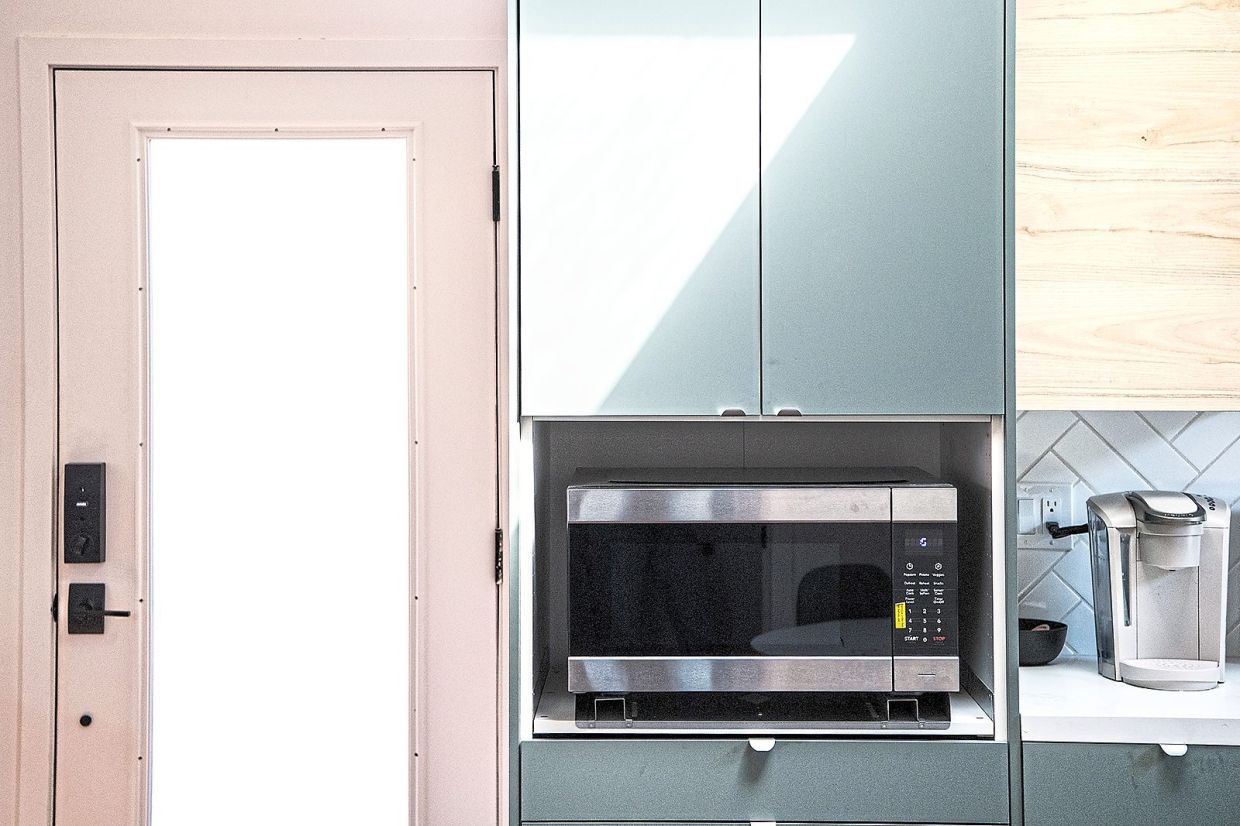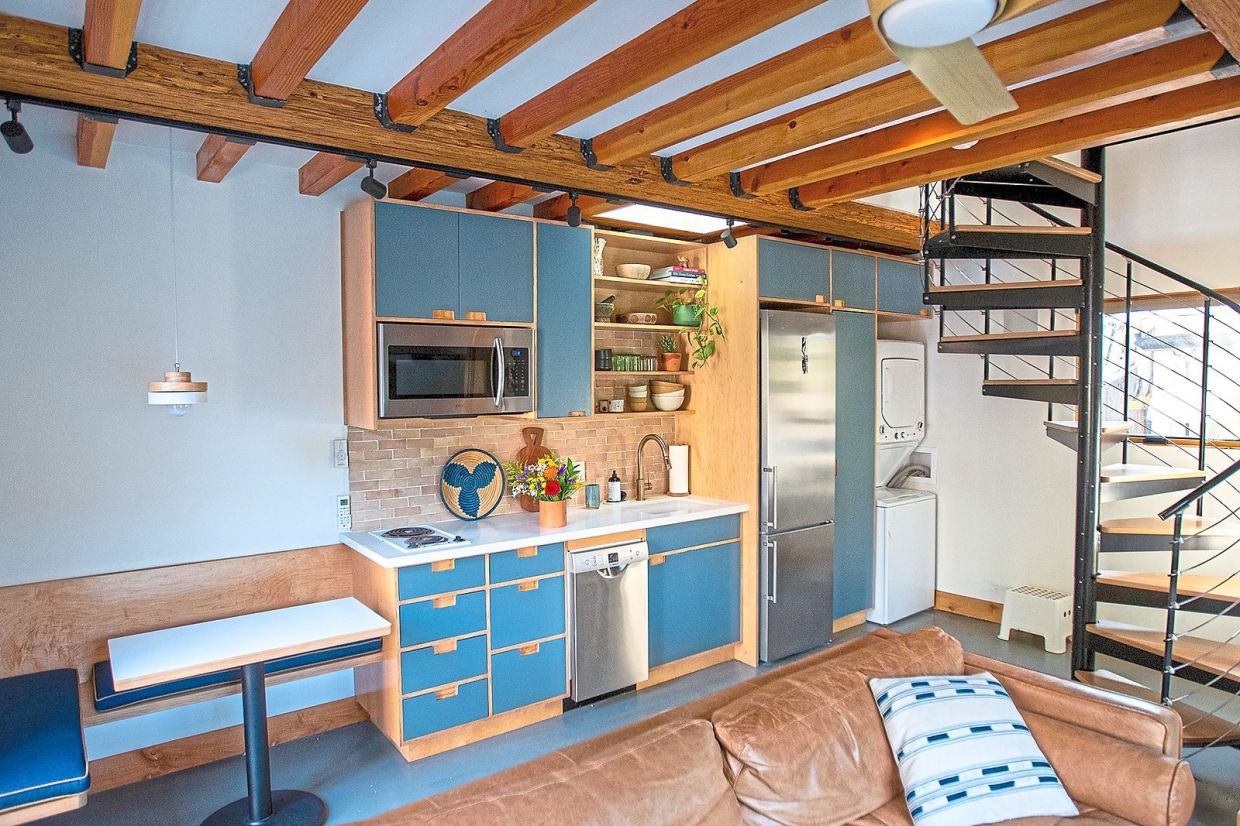The prefab kitchen in South Bay, LA came with standard, full-size appliances – an electric range/oven, dishwasher, refrigerator, microwave and washer and dryer. Photos: TNS
Unlike European kitchens, which are designed for efficiency rather than luxury, American kitchens often emphasise open-concept designs simply because they are larger.
But now that people are adding accessory dwelling units, or ADUs (similar to tiny homes), in their backyards to house family members and generate passive income, the European model is becoming more attractive to homeowners struggling to fit everything they want into a tiny footprint.
“I wish appliance companies made cooler and more compact appliances,” says designer Samantha Karim, who added an ADU in her Mid-Wilshire backyard in Los Angeles, California, the United States. “This is especially true as people are trending towards smaller living spaces.”
Los Angeles architect Bo Sundius agrees.
“No one is making an inexpensive small refrigerator,” he says.
“You have to go with European models. I would always do under-counter fridges and freezers if I could, but there’s nothing on the market that’s affordable.”
Designing a kitchen for an ADU requires careful planning, says designer Kirsten Blazek, author of the new book A 1000 X Better. A Rebel By Design.
“I like to start by really thinking about the main purpose of the space and plan accordingly,” she says. “Will there be long-term guests there? Who would benefit from a full kitchen? Is this more of an overflow, entertaining or work space?
“Space planning and functionality are important, so don’t forget to get the correct-sized appliances. Measure everything carefully. Also, give the same attention to design details as you would in a full-size kitchen.”
Blazek is not alone in wanting her kitchen to be efficient. Here, architects and homeowners share their small-space tips for ADUs to help you maximise your space and living experience.
Sunny, open kitchen
A two-bedroom rental on a dense lot in Highland Park, LA, this ADU is 850sq ft (79sq m) in size and includes a full kitchen with custom cabinets and standard, full-sized appliances, including a refrigerator and a 30in (76cm) range. There is no dishwasher, but there is room for one.
Clerestory windows bring in light and make the space feel bigger. Despite the small footprint, architects Bo Sundius and Hisako Ichiki of Bunch Design added a tall cabinet opening for storing a large Kitchen Aid mixer.
The architects dislike upper cabinets because they are inefficient.
“Don’t do upper cabinets,” Sundius advises homeowners. Instead, add a wall of storage.
“You can hide a cheaper standard refrigerator because it is in plane with the cabinets. If the cabinets and refrigerator are white, it will look integrated.”
Sundius shares a pro tip: “People are always obsessed with picking out the countertops. They believe that Caesarstone never stains or scratches. That’s not true. They always choose white Caesarstone and then are disappointed when it stains. Granite and quartzite are always going to be the best-performing stones. Pick something with movement in it – darker stone will hide stains.”
A glamorous chef’s kitchen
At 290sq ft (27sq m), this project is a studio garage conversion in LA’s Pacific Palisades.
Homeowners Nicole Fitzgerald and Rick Steil wanted a full kitchen in their former one-car garage, despite its small footprint.
“We imagined the space as a multipurpose room for multiple tenants,” says Fitzgerald. “So we thought a full kitchen would be an important functional feature. In addition, we love to cook and entertain and spend a tremendous amount of time in our current kitchen.
“We love the Arabescato stone – it’s absolutely gorgeous and strikes a perfect balance between elegance and playfulness,” says Fitzgerald. “The blue-green cabinetry colour (Portola Half Moon Bay) really drives the personality of the entire space while enveloping the beautiful ILVE range and custom plaster hood as a beautiful focal point for the entire room.”
In retrospect, Fitzgerald believes they could have gone without the dishwasher.
“I believed that a dishwasher would add important functionality for hosting and entertaining groups of people, but in reality, the space is more suited for one to two people,” Fitzgerald adds.
“If I could tweak the ADU, I might opt for more storage/pantry space instead of the dishwasher.”
Designed with disability in mind
This 500sq ft (46.5sq m) ADU was designed for a disabled family member in Culver City, California. Its Ikea kitchen includes an electric stove, microwave, refrigerator, dishwasher and sink.
“We love our ADU kitchen,” says homeowner Andrea Villicana-Chavez. “The architect suggested we get the kitchen from Ikea, and it’s larger than I thought it would be, with ample countertop space. It takes up two walls; it could have been smaller, taking up less space, but as it turns out, it’s better this way.”
Villicana-Chavez is pleased with the kitchen’s design and overall price.
“It was very affordable compared to other kitchens,” she says. “The only con I see is the electric stovetop. It’s hard to clean at times with just soap and water. I just ordered some cleaner for glass-top stoves to see if I can remove the burned food that doesn’t seem to come off.”
Modern minimalism
This one-bedroom predesigned rental in Fairfax District, LA is 400sq ft (37sq m) in size. A former one-car garage, it includes a panel-ready Fisher and Paykel refrigerator, a 24in (61cm) Bertazzoni oven range, a sink and a dishwasher.
“We like panel-ready appliances because when you reduce clutter, it makes the place feel bigger,” says architect Sundius, who also designed the Highland Park rental. The washer and dryer are in the bathroom.
Although ADUs are a modern solution to the housing shortage in the US, Sundius notes that it is “still a suburban model, and everyone wants a laundry machine”. He prefers to house the laundry in the bedroom or bathroom, not the kitchen.
“Even a studio has a bathroom, and it’s nice if you have a slight vestibule so the door is not right there. We’ve also done the laundry machine combo under the vanity in the bathroom, but people complain that (compact appliances) break.”
Country kitchen
A prefab ADU rental for family members in South Bay, LA, this 850sq ft (79sq m) unit came with standard, full-size appliances: an electric range/oven, dishwasher, refrigerator, microwave and washer and dryer.
“The kitchen appliances are all Whirlpool by default and have a coordinating stainless-steel style, which was fine with us,” says Melanie Guevara, who lives in her parents’ backyard with her husband, Devon Hollowood.
“Devon and I had spent so much of the last decade, while in college and graduate school, living in student-grade apartments with shared laundry rooms and no dishwasher. So it was important to us to have our ADU feel like a fully functional and comfortable home.”
The ADU is fully electric.
“We did have the option to run a gas line during construction and have a gas stove instead. While I prefer cooking with a traditional gas stove, we decided it was not worth the extra expense and potential health and safety risks.
“We hope to install solar panels someday so our home is as efficient and environmentally friendly as possible,” says Guevara.
The couple love their refrigerator, which conveniently dispenses filtered water and ice, and their giant farmhouse-style apron sink.
“We love our kitchen island, which provides extra counter space, storage and electrical outlets.”
“(However) I am not a fan of the glass cooktop on our electric oven; it scratches easily and requires a lot of maintenance to keep it looking clean,” says Guevara.
“The stainless steel faces of our appliances also take more cleaning than I expected to eliminate water streaks and small rust spots.”
No-nonsense kitchenette
Architect and homeowner Jefferson Schierbeek and his wife Su Addison have lived in their 300sq ft (28sq m) above-garage studio rental in Mar Vista, LA – which they designed – for more than a year.
Schierbeek describes its kitchen as “an attempt at what we might consider the elegant minimum. You can get everything done in a very small space, and it has all the required items.
Sink, under-counter refrigerator, cooktop (electric), and oven (convection/ microwave)”.
“Higher ceilings always make a space feel more generous,” Schierbeek says. “We made the compact kitchen feel larger by placing ample windows near and in the space and wrapping the rubber/cork composite floor surface up the wall for continuity with the living space.
“(However) it is a challenge to cook complicated meals, but the space works reasonably well for its size and has everything you need. The biggest challenge might be storage.... We designed as much storage as we could.
“Winnowing down to the basic pots, pans, utensils and service wear was necessary, and using open shelving does allow for some flexibility.” – Los Angeles Times/Tribune News Service
The prefab kitchen in South Bay, LA came with standard, full-size appliances – an electric range/oven, dishwasher, refrigerator, microwave and washer and dryer. Photos: TNS
The first floor of the two-storey dwelling includes a dining nook, kitchen, bathroom, laundry and multipurpose room.
Photo: Allen J. Schaben/Los Angeles Times/TNS
Olive green cabinets are paired with cream-coloured countertops in this kitchen.
Photo: Mariah Tauger/Los Angeles Times/TNS
This Ikea kitchen includes an electric stove, microwave, refrigerator, dishwasher and sink.
Photo: Mariah Tauger/Los Angeles Times/TNS
Douglas fir cabinets and white tile make the tiny space look bigger.
(Mariah Tauger/Los Angeles Times/TNS)
In addition to an ILVE range, this kitchen in a studio garage conversion in LA’s Pacific Palisades has a terracotta-tile backsplash, grey millwork and a marble-topped island.
(Mariah Tauger/Los Angeles Times/TNS)
Exposed beams give low ceilings the illusion of height.
(Allen J. Schaben/Los Angeles Times/TNS)
A 24-inch Bertazzoni oven range fits into this one-bedroom predesigned ADU in Fairfax District, LA fitted with wood cabinetry.
(Mariah Tauger/Los Angeles Times/TNS)
This bright open kitchen in a Highland Park rental is a simple custom design with clerestory windows that let in light.
(Mariah Tauger/Los Angeles Times/TNS)














